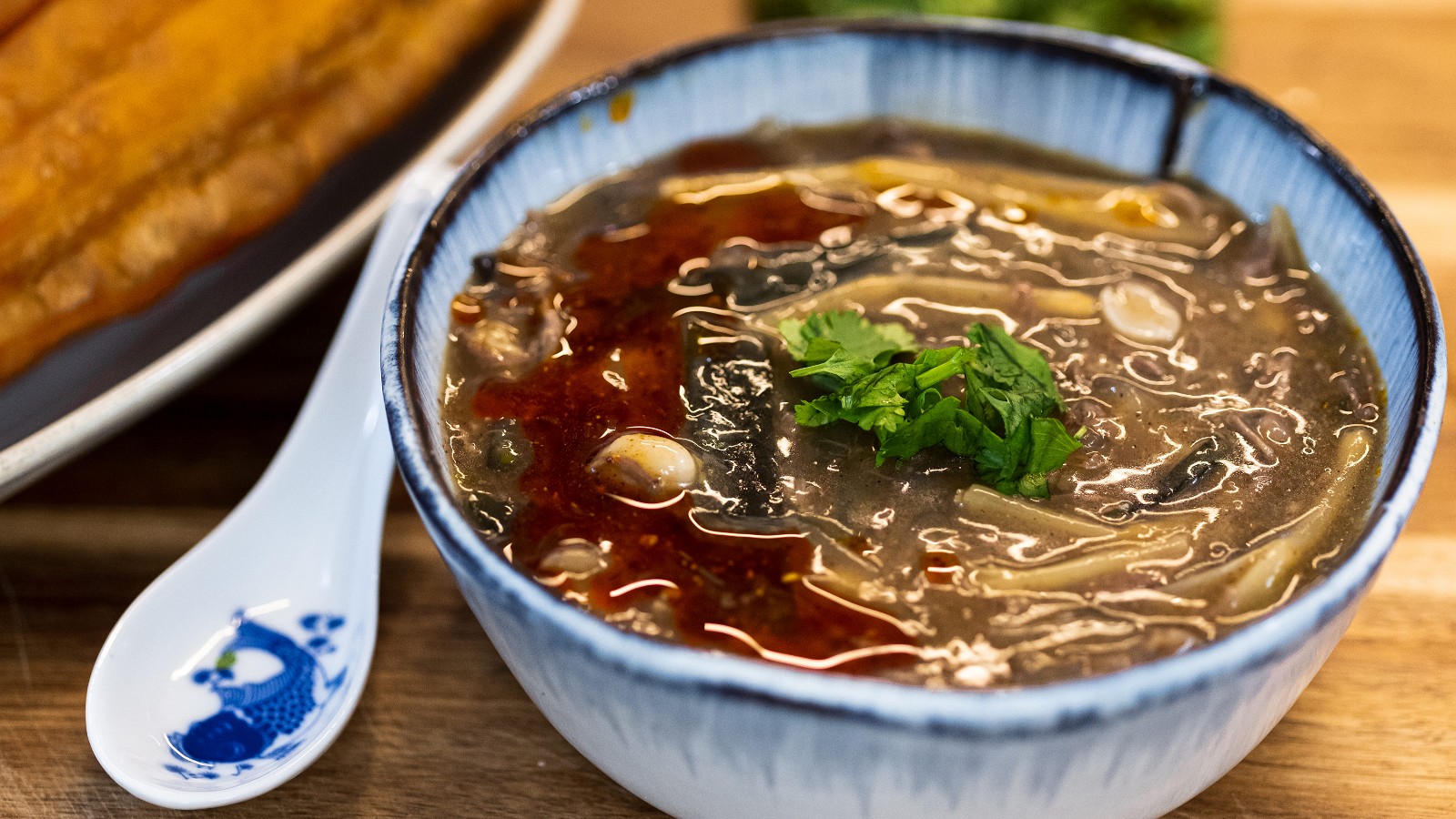WINTER WARMER – Hot Pepper Soup (河南胡辣汤)
Rated 4.3 stars by 4 users

Ingredients
- 300 grams 10.6 oz of bread flour
- 175 grams 6.2 oz of water to make the dough
- 1.6 kg 3.5 lbs of beef bones & meat I used 1.5 lbs of beef ribs and 2 lbs of beef neck
- 2.5 liters 10.5 cups of boiling hot water
- 25 grams 0.9 oz of dried day lily 黄花菜
- 60 grams 2.1 oz of raw peanut 花生
- 10 grams 0.35 oz of dried wood ear fungus 木耳
- 18 grams 0.63 oz of dried kelp 海带
- 85 grams 3 oz of sweet potato starch noodles 红薯粉条 红薯粉条
- 2.5 tsp of white pepper 白胡椒
- 2.5 tsp of black pepper 黑胡椒
- 3 piper longum AKA long pepper 荜茇
- 1.5 tsp of Sichuan peppercorns 花椒
- 1/2 of star anise 八角
- 1/4 tsp of fennel seeds 小茴香
- A small piece of cinnamon stick 桂皮
- 1/8 of a nutmeg 肉蔻
- 1 piece of Angelica dahurica root 白芷
- 2 pieces of Licorice root 甘草
- 1 piece of Amomum villosum pod 砂仁
- 1/4 of a black cardamon 草果
- 1 white cardamon 白豆蔻
- 2 cloves 丁香
- 1 tsp of ginger powder 姜粉
- 1/2 tbsp of diced ginger
- 1.5 tbsp of diced garlic
- 3 tbsp of diced scallion
- 1 tbsp + 1/2 tsp of salt
- 3 tbsp of soy sauce
- 1/2 tbsp of dark soy sauce
- Diced cilantro as garnish
- Hot chili oil Optional
Directions
In a mixing bowl, combine 300 grams of bread flour and 175 grams of water. Knead it into a smooth and nonstick dough. Rest for 30 minutes.
- 30 minutes later, fill a big bowl with water and wash the dough for 10 minutes or until the gluten and the starch are fully separated.
- Soak the gluten so it doesn’t dry out. Set it aside.
- Pour the starch water through a sieve to get rid of any gluten bits. Let the starch water sit for at least 6 hours to allow the starch to sink to the bottom completely. Then discard the topwater carefully. Set it aside.
- Blanch the beef: Fill a pot with water and add 1.5 pounds of beef ribs and 2 pounds of beef neck. Cover it. Turn the heat to high and bring it to a boil. Once it comes to a boil, skim off the foamy scum by using a fine sieve.
- Take the beef out. Discard the water. Wash the pot, then add the beef back in. Pour in 2.5 liters of boiling hot water and turn the heat to the lowest. Let it simmer for 2.5 hours.
- Soak 60 grams of raw peanut, 25 grams of dried day lily flower, 18 grams of dried kelp, and 10 grams of dried wood ear fungus, and 85 grams of sweet potato starch noodles for 2 hours or until they are fully rehydrated.
- Remove the peanut skin if there is any.
- Rinse the kelp to remove the slippery mucus. Then cut it into 2-inch-long strips.
- Slice the wood ear fungus thinly.
- Cut the sweet potato noodles into 2-inch-long pieces.
- Toast the spices in a cast-iron skillet on low heat for 3-5 minutes or until fragrant. Put the spices in a bowl. Let it cool a little bit. Transfer them into a grinder and blend everything finely.
- Let it go through a sieve to get rid of any stubborn pieces. Last, add 1 tsp of ginger powder. Stir to mix and set it aside.
- By now, the stock should be ready. Take the beef out. Remove the bones and shred the meat.
- Add in the peanuts, shredded beef, diced scallion, diced garlic, minced ginger into the beef stock. Turn the heat to low, continue to cook.
- Stretch the gluten and rip it into small little pieces then put it in the broth.
- Continue by adding the rehydrated day lily, kelp, wood ear fungus, and sweet potato starch noodles.
- Season the soup with salt, soy sauce, dark soy sauce, and the spice powder by taste.
- Take out the starch water. Stir to mix. Use it to thicken up the soup.
- Top it with some diced cilantro. If you like it to be spicier you can drizzle in a little hot chili oil. This soup is commonly accompanied by deep-fried dough sticks. You can cut them into bite-sized pieces and soak them into the soup. In Henan province, local people will eat this as breakfast like every day. To me, it is definitely a winter warmer - better than a goose down jacket because every time I eat it, I can just feel the heat building up all over my body.




































































